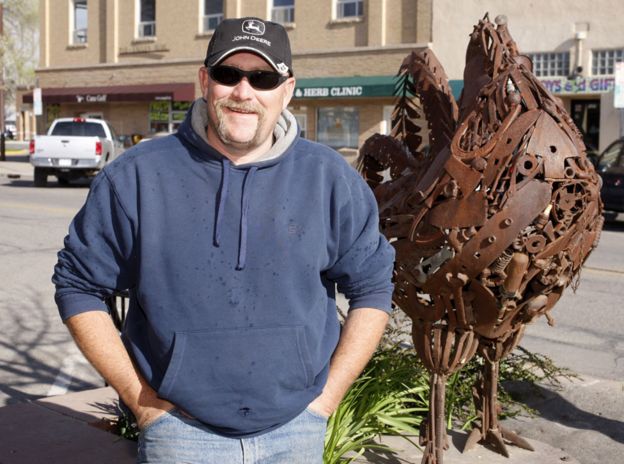The BBC has a good article about Mike the Headless Chicken. Seventy years ago today a legend was created:
On 10 September 1945 Lloyd Olsen and his wife Clara were killing chickens, on their farm in Fruita, Colorado. Olsen would decapitate the birds, his wife would clean them up. But one of the 40 or 50 animals that went under Olsen’s hatchet that day didn’t behave like the rest.
“They got down to the end and had one who was still alive, up and walking around,” says the couple’s great-grandson, Troy Waters, himself a farmer in Fruita. The chicken kicked and ran, and didn’t stop.
It was placed in an old apple box on the farm’s screened porch for the night, and when Lloyd Olsen woke the following morning, he stepped outside to see what had happened. “The damn thing was still alive,” says Waters.
“It’s part of our weird family history,” says Christa Waters, Troy’s wife.
[Troy Waters standing in front of a statue of Mike the Headless Chicken]
Some people think that Mike the Headless Chicken poses a problem to the halakhic concept of pesik reishei. This phrase is used by the Gemara in many places (e.g. Shabbat 75a and Ketuvot 6a) to refer to an inevitable unintended consequence.
But Abaye and Raba both maintain: R. Simeon admits in a case of ‘cut off his head but let him not die!
Here is Rambam (Hilkhot Shabbat 1:6)
When one performs a deed that results in the performance of a forbidden labor, and it is a certainty that this deed will cause [that labor] to be performed, one is liable even though one did not intend [to perform the forbidden labor].
What is implied? A person needs a fowl’s head to serve as a toy for a child, and therefore cuts off the [fowl’s] head on the Sabbath; although his ultimate purpose is not merely to slaughter the chicken,15 he is liable. It is obvious that it is impossible for the head of a living being to be cut off and for that being to survive. Instead, the [fowl’s] death came about because of [this activity]. [Therefore, he is liable.] The same applies in other similar situations.
The truth is that we know that even when the Gemara states a principle in specific terms, it does not necessarily mean that it is 100%. It means that it is true the overwhelming number of times. Look at Maharsha on Shabbat 120b (s.v. ve’od de’im ken) where he explains that Rav considers an event to be pesik reishei if it will occur almost every time. See Yam Shel Shelomo on Chullin chapter 3 se’if 80 who writes that something that will occur less than one time in a thousand is considered as a certainty by the Gemara.
And with Mike, they certainly did try to make another headless chicken many, many times, all without success.
Troy Waters suspects that his great-grandfather tried to replicate his success with the hatchet a few times.
Certainly, others did. A neighbour who lived up the road would buy up any chickens for sale at an auction in nearby Grand Junction, Colorado, and stop by the family farm with a six-pack of beer for Olsen, to persuade him to explain exactly how he did it.
“I remember [him] telling me, laughing, that he got free beer every other weekend because the neighbour was sure he got filthy rich off this chicken,” Waters says.
There are about 50 billion chickens killed every year for food. I would say that an event which occurs once in 50 billion (times 70 years) times is equivalent to something that never happens at all. Alternatively you could call it a miracle. Which would be better for ticket sales.
You can even watch a video about Mike the Headless Chicken on youtube

